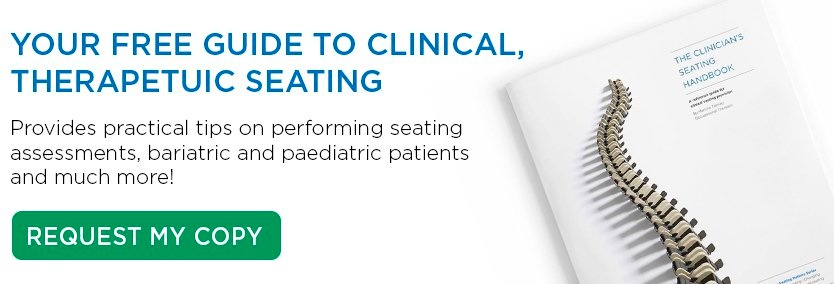Do you know why the footplate is important? In clinical, therapeutic seating the footplate is essential in order to stabilize the feet which can effect posture, function and the overall quality of life for a patient.*
WHY IS THE FOOTPLATE ESSENTIAL IN SEATING?
- Pressure Management: 19% of the average person’s body weight is taken through their feet, therefore the feet should be properly loaded on a suitable footplate in order to manage the pressure distribution throughout the body.
- Stability: For functional movement to occur in sitting, stability of proximal body parts (pelvis, spine and shoulders) is a prerequisite for distal control.
If the patient is not properly loaded or supported in their chair they may be forced into a posterior pelvic tilt and may use their feet/heels/ankles to stabilize themselves. The heels/ankles are bony prominences, which can be subject to pressure ulcers/injuries if the body and the feet are not loaded properly. The stability of a patient's feet being fully loaded on an appropriate footplate can reduce the risk of sliding and falls from the chair, and contributes to good posture in sitting.
- Increased Function: Loading the feet properly on an appropriate footplate makes the patient more stable and secure in their chair, especially during transfers. When a patient is stable they feel safe within the chair, and with their feet firmly resting on the footplate, they are able to maintain a greater level of independence and can assist in seated to standing transfers allowing them some mobility.
HOW CAN YOU CORRECTLY LOAD THE FEET?
Things to consider:
- Seat Depth: In order to load the feet properly in neutral, the femurs should be correctly loaded in a chair with an appropriate seat depth which has been adjusted to suit their leg length.
If the seat depth is too short they may exert more pressure through the feet and if the seat depth is too long they may be at risk of being pulled into a posterior pelvic tilt/sacral sitting position, increasing the risk of pressure injuries in this exposed area of the sacrum.
- Seat Height: In assessing the client during a seating assessment, for seat height, the critical measure is their popliteil height which is measured from the back of the knee to the heel, and ensuring the footplate is in optimal position so the feet can be loaded evenly.
- Back Angle Adjustment: The back angle of the chair should be assessed to correctly suit the individual patient, and properly measured and set to accommodate their hip angle to ensure the pelvis is in optimum position for full body loading and correct posture.
- Tilt in Space: When we use tilt in space with patients we must ensure the feet are properly loaded to provide comfort and support for the user when they are repositioned.
- Fully Loading The Feet: This means loading the feet flat on the footplate. If the patient’s feet are in plantar or dorsal flexion we can accommodate that within our Sorrento and Phoenix chairs which have an angle adjustable footplate.
- Leg Laterals: for patients with involuntary movements and those who need extra stability in this area, we can add leg laterals to the calf pad for additional support.
- Condition of The Patient: i.e. does the patient need added pressure management for the feet, if so we can provide a padded footplate.
IT IS ESSENTIAL TO LOAD THE FEET AS PART OF LOADING THE BODY
That is why all of the Seating Matters chairs come with a footplate as standard.
To learn more about clinical seating provision, request a copy of The Clinician's Seating Handbook for a more in-depth look at seating in care facilities, hospitals and private homes.
*Note - the purpose of this blog is to give an overview of the product with some tips to consider on its use. This is not intended to be a substitute for professional or medical advice, diagnosis, prescription or treatment and does not constitute medical or other professional advice. For advice with your personal health or that of someone in your care, consult your doctor or appropriate medical professional.






